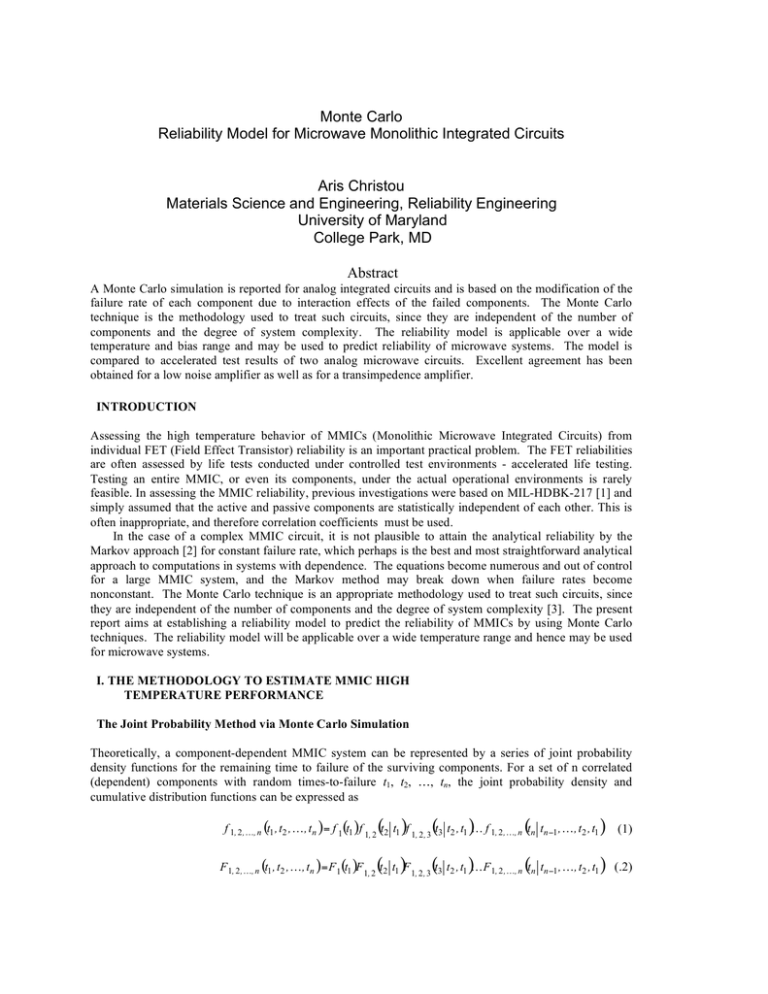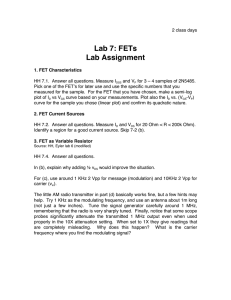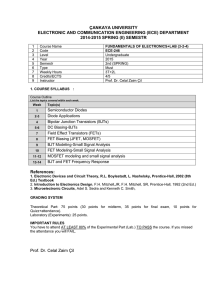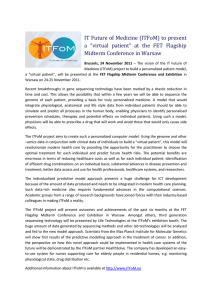Monte Carlo reliability - Aris Christou
advertisement

Monte Carlo
Reliability Model for Microwave Monolithic Integrated Circuits
Aris Christou
Materials Science and Engineering, Reliability Engineering
University of Maryland
College Park, MD
Abstract
A Monte Carlo simulation is reported for analog integrated circuits and is based on the modification of the
failure rate of each component due to interaction effects of the failed components. The Monte Carlo
technique is the methodology used to treat such circuits, since they are independent of the number of
components and the degree of system complexity. The reliability model is applicable over a wide
temperature and bias range and may be used to predict reliability of microwave systems. The model is
compared to accelerated test results of two analog microwave circuits. Excellent agreement has been
obtained for a low noise amplifier as well as for a transimpedence amplifier.
INTRODUCTION
Assessing the high temperature behavior of MMICs (Monolithic Microwave Integrated Circuits) from
individual FET (Field Effect Transistor) reliability is an important practical problem. The FET reliabilities
are often assessed by life tests conducted under controlled test environments - accelerated life testing.
Testing an entire MMIC, or even its components, under the actual operational environments is rarely
feasible. In assessing the MMIC reliability, previous investigations were based on MIL-HDBK-217 [1] and
simply assumed that the active and passive components are statistically independent of each other. This is
often inappropriate, and therefore correlation coefficients must be used.
In the case of a complex MMIC circuit, it is not plausible to attain the analytical reliability by the
Markov approach [2] for constant failure rate, which perhaps is the best and most straightforward analytical
approach to computations in systems with dependence. The equations become numerous and out of control
for a large MMIC system, and the Markov method may break down when failure rates become
nonconstant. The Monte Carlo technique is an appropriate methodology used to treat such circuits, since
they are independent of the number of components and the degree of system complexity [3]. The present
report aims at establishing a reliability model to predict the reliability of MMICs by using Monte Carlo
techniques. The reliability model will be applicable over a wide temperature range and hence may be used
for microwave systems.
I. THE METHODOLOGY TO ESTIMATE MMIC HIGH
TEMPERATURE PERFORMANCE
The Joint Probability Method via Monte Carlo Simulation
Theoretically, a component-dependent MMIC system can be represented by a series of joint probability
density functions for the remaining time to failure of the surviving components. For a set of n correlated
(dependent) components with random times-to-failure t1, t2, …, tn, the joint probability density and
cumulative distribution functions can be expressed as
f 1, 2 ,…, n (t1 , t2 , … , tn )= f 1 (t1 )f 1, 2 (t2 t1 )f 1, 2 , 3 (t3 t2 , t1 )… f 1, 2 ,…, n (tn tn !1 , … , t2 , t1 ) (1)
F 1, 2 ,…, n (t1 , t2 , … , tn )= F 1 (t1 )F 1, 2 (t2 t1 )F 1, 2 , 3 (t3 t2 , t1 )… F 1, 2 ,…, n (tn tn !1 , … , t2 , t1 ) (.2)
where f1(t1) and F1(t1) are probability density and cumulative distribution functions of component 1 (the
first failed component), and f1,2, …, i (ti | ti-1, …, t2, t1) and F1, 2, …, i
(ti | ti-1, …, t2, t1) are the conditional
probability density and cumulative distribution functions of component i given that components 1, 2, …, i 1 have failed. Since the random times-to-failure are dependent, a set of uniformly distributed numbers can
not be used to generate the times-to-failure corresponding to components 1, 2, …, n. An alternative method
is to let (x1, x2, …, xn) denote a set of uniformly distributed random numbers which are between 0 and 1.
Then the random time to failure t1 corresponding to the first failed component 1 can be determined from
(3)
t1 = F1!1 (x1 )
With the value of t1 known, the conditional distribution function F1, 2(t2 | t1) becomes a function only of t2,
and it can be inverted to find t2 as
t 2 = F2!1 (x2 t1 )
(4)
This recursive procedure is continued until the last time to failure tn is generated as:
t n = Fn!1 (xn t n!1 , … , t 2 , t1 )
(5)
We can repeat the above procedure until a desired sampling size N is obtained. The reliability and mean
time to failure (MTTF) of the system can then be estimated as
R=
Ns
N
(6)
N
!TTF
i
MTTF =
i =1
N
(7)
where Ns is the number of successes (i.e., random time to failure is greater than designated lifetime) and
TTFi is the random time to failure for sampling i. The above technique is applicable for cases where the
joint cumulative distribution functions are known. In the case of a complicated MMIC, however, the joint
cumulative distribution functions are not easily obtained. Therefore, an alternative method has been
proposed and applied to estimate the reliability of MMIC by introducing a weighing factor w(nf, t) which
will be discussed later.
The Non-Markovian Method via Monte Carlo Simulation
Most IC system reliability studies assume that the components' failure rates λ are constant [4]. This is a
very common assumption for most applications. However, if the assumption of constant failure rate is not
valid such as in MMIC circuits, then the system becomes non-Markovian [5] and additional techniques are
required for handling this process (MMIC circuits are non-linear). The way of generating the histories for a
non-Markovian system is the same as that for a Markovian system [6]. Any one of the generated histories
is composed of many time-segments and each time-segment represents a state change. The total failure rate
of the system is given as:
n
#(t )=
! " (t )
i
i =1
(8)
where λi(t) is the failure rate of component i at time t. The probability density f(t) that the state change will
occur at time T + t, if the previous state change occurred at T, would be
t
'
$
%
"
f (t )= ((t )exp % ) ((x )dx " , T < t < !
(9)
% T
"
&
#
*
Therefore, the cumulative probability F(t) that there is a state change before t, if the last state change at T,
is given by
t
y
'
$
%
"
F (t )= ((y )exp % ) ((x )dx " dy
(10)
% T
"
T
&
#
!
!
In a Monte Carlo simulation, a random number is generated as x, uniformly distributed between 0 and 1, to
stand for the cumulative probability function F(t), i.e.,
T +"
x = F (")=
!
T
t
(
%
&
#
)(t )exp & * )(x )dx # dt
& T
#
'
$
!
(11)
The time to failure t for this particular time-segment will then be calculated by the following equation.
" = F !1 (x )
(12)
This inversion of F(t) can be carried out either analytically or numerically. The above procedure is
repeated until the desired sampling size is obtained. The reliability and MTTF are determined by Equations
(8) and (9).
The MMIC Monte Carlo Technique
For the MMIC Monte Carlo simulation, it is convenient to define the inter-component dependence by
modifying the failure rate for each surviving component due to the interaction effects of the failed
components. The failure of a component would then involve choosing the proper combination of
components and the corresponding failure rates to generate the remaining times-to-failure. The
modification of the failure rates of dependent-components may not have any identifiable pattern, and may
involve changing the type or parameters of probability density function. For a given component, the failure
rate changes are expected to depend on the failed components. The modified failure rate can be expressed
as:
(
)
!' (t )= ! ii (t )+ ! ij (t )+ ! cc (t )= W ni , n f " ! ii (t )
(13)
where
λii is the failure rate due to component i itself,
λij is the failure rate due to interactions between components i and j,
λcc is the failure rate due to common cause, and
W(ni, nf) is a weighting function of component ni and failed components nf.
The function W is always equal to or greater than 1. If it is 1, then there is no interaction between
components. If it is very large, then there is strong interaction between components and these components
can be put in series in the reliability block diagram.
II. MMIC CIRCUIT RELIABILITY MODEL
The Given Conditions for MMIC Reliability Model
In general, several conditions must be given in order to establish a practical MMIC circuit reliability model,
and these are summarized as follows:
1) The MMIC system is composed of m statistically-dependent subsystems (or stages, Figure 1), while
the ith (i = 1, …, m) subsystem (or stage) consists of ni statistically-dependent and non-repairable
components. Therefore, the MMIC system consists of n components where:
m
n=
!n
i
(14)
i =1
and where each component is in either a failed or operating state.
2) Dependent failures can be due to a common cause (the failure of multiple components due to a single
mechanism such as catastrophic or environmental failure), to interactions within a subsystem, and
to interactions between subsystems. Due to the component failure interaction, the failure rate of the
component (or subsystem) would increase once the neighboring components (or subsystems) have
failed.
Out
PC1
PC: Passive Component
FET: Field Effect Transistor,
Active Component
FET
Subsystem 1
FET
FET
PC2
FET
FET
FET
Subsystem 2
FET
PC3
PC4
FET
FET
FET
FET
FET
FET
FET
FET
FET
FET
FET
FET
FET
FET
Subsystem 3
PC5
PC6
FET
FET
FET
FET
FET
FET
PC7
PC8
FET
FET
FET
FET
FET
FET
FET
FET
FET
FET
FET
FET
FET
FET
FET
FET
PC9
PC10
FET
FET
FET
FET
FET
FET
FET
FET
FET
FET
FET
FET
FET
FET
FET
FET
FET
FET
FET
FET
PC11
PC12
In
Figure 1 A Typical Reliability Block Diagram of a Multi-Stage MMIC
3) A single failure mechanism can affect several components, and a given component can be affected
by several mechanisms and these mechanisms are statistically-independent.
4) Failure rate λ of a component i would be the sum of λii (due to failure mechanism for component i
itself), λ ij (due to interaction by component j) and λcc (due to a common cause such as catastrophic
failures which result a system failure as a whole). The interactions between passive components will
be neglected.
5) Figure 2 shows the reliability schematic of a TIA MMIC system. The effects of interactions among
series connections may be neglected, since the path associated with the failed component has also
failed. For example, if component 5 in Figure 2 has failed, the path (5-6) through it has also failed
(open circuit). Component 6 is assumed to be non-operating. The interaction caused by
components 5 and 6 therefore can be ignored.
In
FET1
FET5
FET7
FET9
FET6
FET8
FET10
FET3
FET2
FET4
Out
Figure 2 The Reliability Block Diagram of TIA
6) The effects due to interactions are the same for the surviving components for the same subsystem.
However, the effects of interactions among parallel active redundant FETs will be taken into
account. As known, the stress of an active redundant component will increase once the neighboring
components have failed. The stress will also increase with respect to the number of failed
components, and this causes the survivors to have a higher failure rate. Referring to Figure.2,
! 2 > !1 > ! 0
where
λ2 is the failure rate of component 9 (or 10) for given failed paths 1-2 and 7-8,
λ1 is the failure rate of component 9 (or 10) for given failed path either 1-2 or 7-8, and
λ0 is the failure rate of component 9 (or 10) for no failed path.
(7) The effects due to interactions are the same for the surviving components for the same subsystem.
For example, if component 7 (or 8) has failed, its effects on components 1, 2, 9 and 10 are the same.
(8) Interactions among components and subsystems are estimated through correlations determined
experimentally if it is possible, or may be estimated by SPICE circuit analysis.
(9) The failure distribution function is given for each independent component. It can be a mixture of
several known failure distribution functions, i.e.,
f = a1 f1 + a2 f 2 + ! + an f n
(15)
where ai is the fraction of the effects due to failure distribution function fi and a1 + a2 + ⋅⋅⋅ + an = 1.
The weighting factors however must be modified after each component failure.
Procedures to Model MMIC Reliability
Two cases have been investigated, and the results as well as the procedures used are summarized as
follows:
Case 1: If the interactions between components can be estimated by the correlation matrix obtained
through SPICE circuit analysis or by experiment, then the steps to model the MMIC system reliability are:
1) Determine the interactions between components through SPICE circuit analysis so that the failure
weighting factor W(ni, nf) can be determined.
2) Identify the failure distribution function for each independent component. Based on the failure
distribution function, select a random number for each component and through the inverse
transformation method calculate a time to failure for each component. The time to failure t of a
component (i.e., FET) related to a random number x is obtained by the proper selection of the
distribution function.
3) If the predicted time to failure of a component is greater than a pre-specified life, then the component
is operational, otherwise it is a failure. Identify the first failed component, and set the component time
to failure to be T.
4) Modify the remaining time to failure of the surviving components by W(ni, nf). The new time to
failure Ti' (i = 2, 3, 4, …, n, and n is the number of components consisting the MMIC circuit) will be
"T
T 'i = Ti !1 +
(16)
W (ni , ni !1 )
or
T 'i = Ti + "T
1 ! W (ni , ni !1 )
W (ni , ni !1 )
(17)
where ΔT is the difference between time to failure Ti of the surviving component i and time to failure
Ti-1 of the failed component i -1.
(5) Step (4) is repeated until the modified T's of all components are obtained, determine the system's time
to failure as the modified T' of the final failed component, compare it to the system's mission life, and
record it as a success or a failure.
(6) Step (2) is repeated until a statistically adequate sampling size is obtained.
(7) Calculate the reliability and MTTF by Equations (8) and (9), and error by the function,
error = 200
R
%
N (1 ! R )
(18)
The flow chart for the methodology is shown in Figure.3. Two types of MMICs, which are the TIA
(Transimpedence Amplifier) and LNAs (Low Noise Amplifier), have been analyzed by applying this
method. Equation (18) as is noted, has been derived from the definition of failure rate λ(t) which is
#(t )=
N f (t + !t )" N f (t )
(19)
N (t )!t
The failure rate λ(t) is an approximately inverse proportion to the surviving time to failure Δt for a fixed
number of failures at time from t to t + Δt. If λ(t) is increased by a weighting factor W(ni, nf), then Δt will
be reduced by a factor of W(ni, nf). The new surviving time to failure, therefore, is modified by Δt/W(ni,
nf), and the modified time to failure will be determined by Equation (18). The relationship between the
correlation coefficient and the weighting factor is obtained by assuming that the difference of time to
failure between the surviving components and the failed component is proportional to the associated
difference of current drift [7], i.e.,
!TTF " !I d
(20)
Select the desired number N
of simulations to be conduced,
and start simulation and set I = 1
Identify the failure distributions function
for each independent component.
Generate a uniformly distributed
random number [ 0 - 1] for each
component.
Transform the generated random
number to the corresponding time
to failure based on its distribution.
Identify the first failed component,
and set the component time to
failure to be T.
Modify the remaining times to failure of
the surviving components by W(ni, nf) till
the final failed component has been
determined.
Determine the failure weighting
factor W(ni, nf) by SPICE analysis
Determine the system’s time to
failure as the modified T’ of the
final failed component
Compare the modified T’ with the
desired performance to evaluate the
MMIC’s whether the simulation is a
success or a failure.
Is i = N ?
Using the randomly generated set of
parameters to evaluate the random
performance of the system and compare
it with the desired performance to
determine if it is a success or failure.
Figure 3 The flow chart for the reliability estimation of TIA and
LNA holds.
We also note that equation (18) is applicable for both the TIA and LNA. Based on the linear regression
method, if two variables (FETs) have the same (current drift) dispersion, i.e., Si = Sj then the correlation
coefficient is identical to the regression coefficient bij and bji, i.e., rij = bij = bji, and the following relation
!Ti = rij !T j
(21)
!T j = rij !Ti
(22)
where ΔTi (or ΔTj) is the difference of time to failure between component i (or j) and the failed
component j (or i) (Figure.4).
Equation (23) can be generalized as:
(
)
(23)
Ti" = Ti ! ri , i !1 (Ti !T i !1 )
(24)
T j" = T j ! rij T j !T i
Comparing Equation (19) with Equation (23), the relationship between correlation coefficient and the
weighting factor is determined by the following equation:
1 ! W (ni , ni !1 )
W (ni , ni !1 )
1
W ni , n j =
1 ! rij
! ri , i !1 =
(
)
(25)
(26)
Steps (4) and (5) can be explained as in Figure 4 in which random times to failure generated can be
arranged so that T1 < T2 < ⋅⋅⋅ < Tn and W(1, 2, …, n - 1) is the weighting factor due to failures of
component 1, 2, … , n - 1.
1
T1
) T1
2
T2
T2' = ) T1/W(1) + T1
) T2
3
T3' = ) T2/W(1, 2) + ) T1/W(1) + T1
) T2/W(1, 2) + T2'
T3
) T3
4
T4
T4' = ) T3/W(1, 2, 3) + ) T2/W(1, 2) +
) T1/W(1) + T1
= ) T3/W(1, 2, 3) + T3'
n
Tn
Tn' = ) Tn-1/W(1, 2, 3, ..., n-1) + ...
) T2/W(1, 2) + ) T1/W(1) + T1
= ) TN-1/W(1, 2, 3, ..., N-1) + Tn-1'
Figure 4 The Methodology to Determine the Time To Failure
Case 2: If the correlation between components can not be estimated by SPICE circuit analysis or any
other method, then the steps to model the MMIC system reliability by Monte Carlo techniques can be
stated as follows:
1) Determine from the MMIC circuit the specific groups of s-dependent components and groups of
s-independent components, for example, FET1 through FET14 in Figure 5 are in an s-dependent
group. The failure rate of a component in the s-dependent groups will be affected by the state (failed
or operational) of any other components which are in the same group.
2) Identify the failure distribution function for each independent component. Based on the failure
distribution function, select a random number for each component and through the inverse
transformation method calculate a time to failure for each component.
3) If the predicted time to failure of a component is greater than a pre-specified life, then the component
is operational, otherwise it is a failure. Determine in which s-dependent subsystem the failed
components belong to if a failure has occurred, and then set the component failure time to be T.
4) If the failed components belong to an s-dependent group, then modify the remaining life of the
surviving components in the same by W(ni, nf). W(ni, nf) is determined by assuming that the total
stress upon the s-dependent subsystem (stage) is fixed and also the stress upon the component is
proportion to the failure rate λ of the component. The new failure rate of the surviving component is
obtained as:
n ! o = n " n f !'
(27)
(
)
& (o
(' = n $
$ n ' nf
%
#
!
!
"
(28)
where n is the total number of components in the MMIC system, nf is the number of failed
components, λo is the original failure rate, and λ' is the new failure rate. The weighting factor W(ni,
nf) is estimated by
n
W ni , n j =
(29)
n ! nf
(
)
The new time to failure can still be determined by Equation (18).
5) Step (4) is repeated until the modified T' of all groups is determined and then determine the system's
time to failure from the modified T's and compare it to the system's mission life.
6) Step (2) is repeated until a statistically adequate sampling size is obtained. The flow chart for the
methodology is shown in Figure 6.
PC1
FET1
FET2
FET3
FET4
FET13
FET18
FET33
FET14
PC2
PC3
PC4
FET15
FET16
FET17
FET34
PC5
PC6
Figure.5 Reliability Block Diagram of the Low Noise Amplifier
Select the des ired number N
of simul ati ons to be conduc ed,
and s tart simul ati on and set i = 1
Identi fy the fai lure distributions function
for each independent component.
Generate a uni formly dis tributed
random number [ 0 - 1] for eac h
component.
Transform the generated random
number to the correspondi ng ti me
to failure based on i ts distribution.
Identi fy the fi rs t fai led component and
check w hich group of s-dependent
components belongs to, and set the
component time to failure to be T.
Modi fy the remaining ti mes to fai lure of
the survi ving components in the same
group with fail ed c omponent by W(ni , nf )
no
Fi nish modific ati on?
yes
D etermine the sy stem’s time to
failure as the modifi ed T’ of the
final fail ed c omponent
C ompare the modified T’ w ith the
desired performance to evaluate the
MMIC ’s w hether the si mul ati on i s a
succ es s or a fail ure.
no
yes
Is i = N ?
C al culate the reliabili ty and MTT F by
Equati ons (11.8) and (11.9), and error
by Equati on (11.20).
Figure 6 Flow chart for calculation of MTTF.
III. VALIDATION OF MMIC RELIABILITY MODEL
The two circuit examples have been simulated for both cases . For Case 1, the correlations between FETs
of both TIA and the LNA have been estimated by SPICE circuit analysis, and the Monte Carlo reliability
simulations for both MMICs have also been performed. For Case 2, the LNA and power amplifier have
been analyzed for validation.
LNA and TIA High Temperature Analysis
The assumptions for the reliability analysis are:
1) The relationship between channel temperature (Tj) and median life (tm) is given by Arrhenius
equation and is given as:
&
#
Ea
(30)
t m = t mo exp $
!
%$ k T j + 273 "!
(
)
tmo = 8.332×10-15 for power type or 1.405×10-12 for the LNA, and
k = 8.6×10-5 eV/°K
2) The median life tm at temperature Tm can be estimated by given activation energy (Ea), test
temperature (To) and median life (to)
Where,
&
,1
1 )#
''!
t m = t mo exp $ Ea k ** +
+ T0 Tm ("!
%$
(31)
The overall activation energy was calculated to be 1.6eV for each of the individual FETs.
(3) Time to failure data of the MMIC components tested by previously by the manufacturer most
closely fits a lognormal distribution. Therefore lognormal distributions are used for all FETs. The
lognormal probability distribution function f(t) is given as:
f (t )=
& 1 , ln t . ln t ) 2 #
m
exp $ *
' !
2
t - 2/
( "!
%$ +
1
(.32)
where σ (standard deviation) and tm (median life) are two parameters should be given to determine
operational lifetime t.
4) The interactions between FETs can estimated by applying weighting factor, Wij = 1/(1 - rij) to
modify the time to failure of the surviving components as shown in Figure.4.
(5) The life performance of passive components can be neglected. The computational schematic for
Monte Carlo technique applied to the TIA and the LNA MMIC reliability analysis is shown in
Figure 7, and its algorithm is the following:
INPUT N (the desired sampling size)
While number of sampling n <= N
{For each sampling
{Input number NC of components of the system and
Group them into dependence or independence groups individually
While i <= NC
{Input sigma s and median life tm
Select a random number x
Transform random number x to random time to failure TTF based on its life
distribution}
Determine the component which is failed first and let its time to
failure be T1.
While j <= NC - 1
{Modify the time to failure of all surviving components with a
weighing factor w(ni, nj) based on their correlated relations.}
Determine system time to failure Ti
Compute reliability, MTTF and error
start
n= 1
Ns = Nf = Mttf = 0
i= 1
call random
(seed, rndnum)
i= i+1
Convert rndnum to T(i )
i= I
De termine
Mtrnd
n= n+1
Mtrnd > Mt
?
(refer to
next page)
yes
no
Nf = Nf + 1
Ns = Ns + 1
Mttf = Mttf + mtrnd
no
n = N
?
yes
MTTF = Mttf/N
R = N s/N
Error = 200.*SQRT [R/N*(1 - R)]
stop
Figure 7 Flow Chart for Calculation of MMIC MTTF.
LNA and Power Amplifier Reliability Analysis
The reliability analysis of both the amplifiers is similar as in the previous case except that the s-dependent
groups must be identified and weighting factors must be estimated by Equation (31). With some minor
modifications, the algorithm and computer program for both TIA and LNA are still applicable for both the
LNA and the power amplifier, (see Figure 8).
If the first failed
component belong to
s-dependence
groups?
no
yes
Modify the times to failure T’ of
the surviving components by
T’ = T + ) T/W(ni, nf)
no
Finish modification?
yes
Determine the system’s time to failure
Figure 8 The subroutine to estimate the modified MMIC time to failure
Simulation Results
The results of the reliability simulation for TIA, and the LNA and power amplifier based on discrete
component data are shown in Figures 9 to 11. The simulations by Monte Carlo techniques for both
dependent (modified by a weighting factor) and independent (based on Mil-HDBK method) cases have
been performed. The results show that the estimation of MMICs' life including interactions between FETs
is closer to experimental data than the estimation without taking into account the interactions. The results
also indicate that interdependencies between devices is an important consideration and cannot be ignored.
1000000
Experimental
Monte Carlo - Dep.
MIL-HDBK-Indep.
100000
10000
1000
100
10
1
120
140
160
180
200
220
240
Temperature (EC)
Figure 9 MTTF versus Temperature for TIA
260
1000000
Expe rim e nta l
M on te C arlo - D e p.
M IL-H D BK -In de p .
100000
10000
1000
100
150
170
190
210
250
230
Temperature (EC)
Figure 10 MTTF versus Temperature for the LNA
109
108
107
106
105
104
E G -6010
E G -6010
E G -6203
E G -6203
3
10
E xp.
M .C .
E xp.
M .C .
102
25
125
225
325
Temperature (EC)
Figure 11 MTTF versus Temperature for the LNA and
Power Amplifier
Figures 9 to 11 show that the simulations give a conservative estimation of the MTTF. The excellent
agreement even holds for the temperature range of 225°C through 325°C, thus indicating that the
simulation technique is applicable for high temperature simulations, where large non-linearities exist in the
circuit’s material properties. This investigation has therefore presented the simulation methodology for
analog circuits operating in microwave systems such as MMICs. The approach outlined in this paper may
be used for analog type circuits where the correlation coefficients have been identified.
Conclusions
In the case of a complex MMIC circuit, it is not plausible to attain the analytical reliability by the Markov
approach for constant failure rate, which perhaps is the best and most straightforward analytical approach
to computations in systems with dependence. The equations become numerous and out of control for a
large MMIC system, and the Markov method may break down when failure rates become non-constant.
We have shown that the Monte Carlo technique is the appropriate methodolgy for predicting reliability of
such complex circuits. We have successfully established a new reliability simulation model for MMICs
and have shown that it has a wide applicability to analog circuits in general. The reliability model will be
applicable over a wide temperature range and hence may be used for microwave systems.
REFERENCES
1.
MIL-HDBK-217F, “Reliability Prediction of Electronic Equipment”, pp. 5-7, Sec. 5.4, 1990.
2.
Yonglu Deng and Shibin Song, "Reliability Analysis of A Multicomponent System in A Multistate
Markovian Environment," Microelectron. Reliab. Vol. 33, No. 9, pp. 1237-1239, 1993.
3.
T. Aven, "Reliability Evaluation of Multistate Systems with Multistate Components," IEEE Trans.
on Reliability, Vol. R-34, No. 5, pp. 473-478, 1985.
4.
J. Y. Lin, "A Monte Carlo Simulation to Determine Minimal Cut Sets and System Reliability,"
Proceedings of Annual. R&M Symp. pp. 246-249, 1993.
5.
C. Kim and H. K. Lee, "A Monte Carlo Simulation Algorithm for Finding MTBF," IEEE Trans. on
Reliability, Vol. 41, No. 4, pp. 193-195, 1992.
6.
M. M. Alidrisi, "A Simulation Approach for Computing Systems reliability," Microelectron. Reliab.
Vol. 27, No. 3, pp. 463-467, 1987
7.
S. J. Kamat and M. W. Riley, "Determination of Reliability Using Event-Based Monte Carlo
Simulation," IEEE Trans. on Reliability, Vol. R-24, No. 1, pp. 73-75, 1975.
8.
S. J. Kamat and W. E. Franzmeier, "Determination of Reliability Using Event-Based Monte Carlo
Simulation Part II," IEEE Trans. on Reliability, pp. 254-255, Oct. 1976.
9.
C. L. Hwang, F. A. Tillman, and M .H. Lee, "System-Reliability Evaluation Techniques for
Complex/Large Systems—A Review," IEEE Trans. on Reliability, Vol. R-30, No. 5, pp. 416-425,
1981.
10.
A. Gandini, "Importance and Sensitivity Analysis in Assessing System Reliability," IEEE Trans. on
Reliability, R-39, pp61-70, 1990.
11.
L. B. Page and J. E. Perry, "A Model for System Reliability with Common Cause Failures," IEEE
Trans. on Reliability, R-38, pp406-410, 1989.
12.
S. S. Rao, “Reliability-Based Design,” pp. 505-548, 2nd ed., McGraw-Hill, New York, 1992.
13.
H. Rief, "Generalized Monte Carlo Perturbation Algorithm for Correlated Sampling and A
Second-order Taylor Series Approach," Annals of Nuclear Energy, vol 11, pp455-476, 1984.
14.
J. Yuan, M. T. Lai and K. L. Ko,"Evaluation of System Reliability with Common Cause Failures by
a Pseudo-environments Model," IEEE Trans. on Reliability, R-38, pp328-332, 1989.
15. J. T. H.Lee” The Design of RF Integrated Circuits” Cambridge U.K. Cambridge University Press,
1998.
16. S. S. Naseh and S.H. Deen, “RF CMOS Reliability,” pp. 1249-1295, Vol. 11, No. 2 2001.





